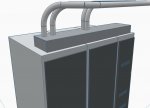JuliaTruchsess
Member
- Location
- Newtown, CT, USA
- Occupation
- Engineer
- How is "ambient temperature" defined with regard to a wireway? My wireway may have one face exposed to a warmer temperature than its other faces. Would the internal temperature of the wireway be considered an adequate measurement of the effective ambient? Can I slap some insulating material on the face exposed to higher temp in order to reduce the "ambient" for derating purposes?
- For cross-sectional fill calculation purposes, is the OD of the wire with insulation used, or the cross-sectional conductor area?
Thanks.


